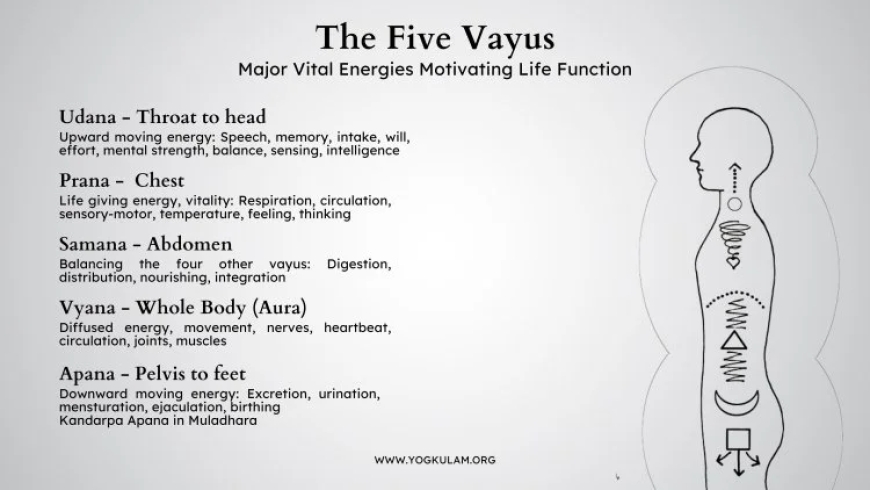Understanding Apana Vayu: Meaning, Function, and Significance in Yoga and Ayurveda
In the practice of yoga and Ayurveda, the concept of Apana Vayu holds great significance. Understanding the Apana Vayu meaning helps us connect with the subtle energies that govern our bodily functions. Apana Vayu refers to the downward-moving energy responsible for elimination, reproduction, and grounding. It is one of the five vital prana vayus that sustain life and balance the body’s internal systems.

In the vast and intricate systems of Yoga and Ayurveda, the concept of Pranathe vital life forceis central. According to ancient texts, Prana is not a singular force but is subdivided into five primary energy currents known as the Pancha Vayus. These five vayusPrana, Apana, Samana, Udana, and Vyanagovern different physiological and energetic functions in the body. Among them, Apana Vayu plays a particularly grounding and purifying role.
If you're new to yogic philosophy or Ayurvedic healing, you might be wondering: Apana Vayu meaningwhat exactly is it?
Apana Vayu Meaning and Definition
The Apana Vayu meaning can be understood by breaking down the term itself. Apana is derived from the Sanskrit root "apa," which means "away" or "downward," and Vayu means "air" or "wind." So, Apana Vayu literally translates to the downward-moving air.
In the context of the human body, Apana Vayu governs all elimination and downward-moving functions. It is responsible for:
-
Excretion (urine and feces)
-
Menstruation
-
Ejaculation
-
Childbirth
-
The general grounding and stabilizing of energy
It resides primarily in the lower abdomen, colon, pelvis, and lower backareas connected to the root chakra (Muladhara).
The Role of Apana Vayu in the Body
Understanding Apana Vayu meaning in daily life requires recognizing how vital it is to both physical and energetic health. In Ayurveda, a disturbance in Apana Vayu can lead to constipation, menstrual disorders, reproductive issues, and lower back pain. Energetically, imbalances may manifest as:
-
Feeling ungrounded or anxious
-
Lack of motivation
-
Fear or insecurity
-
Difficulty letting go of past experiences
On the other hand, when Apana Vayu flows harmoniously, it brings about a sense of calm, clarity, and rootedness. It allows us to release wastephysical and emotionalso we can maintain inner cleanliness and balance.
Apana Vayu in Yoga Practice
Many yogic asanas (postures) and breathing techniques (pranayama) are designed to stimulate or balance Apana Vayu. Forward folds, hip openers, and grounding poses such as:
-
Malasana (Garland Pose)
-
Paschimottanasana (Seated Forward Bend)
-
Supta Baddha Konasana (Reclined Bound Angle Pose)
...are excellent for accessing the downward flow of energy.
Additionally, Mula Bandha (root lock) is a subtle internal practice that directly engages the muscles and energy flow related to Apana Vayu, enhancing stability and energetic control.
In pranayama, slow, deep exhalations are associated with Apana Vayu. Breath retention after exhalation (Bahya Kumbhaka) can also intensify Apana Vayu's effects, helping in detoxification and calming the nervous system.
Apana Vayu and the Chakras
Apana Vayu is intimately connected to the Muladhara Chakra, or Root Chakra. This chakra governs our sense of safety, security, and survival. When Apana Vayu is balanced, we feel grounded and secure in our environment. Blockages in this energy can lead to fear, instability, and a sense of disconnection from the physical body or Earth.
Through grounding yoga poses, meditation on the root chakra, and practices that strengthen Apana Vayu, we begin to feel more anchored in reality. We are better able to let go of what no longer serves usphysically, mentally, and emotionally.
Signs of Imbalanced Apana Vayu
When Apana Vayu is weak or excessive, several imbalances may appear:
Physical Symptoms:
-
Constipation or diarrhea
-
Bladder issues
-
Irregular menstruation
-
Lower back pain
-
Sciatica
Mental/Emotional Symptoms:
-
Feeling spaced out or ungrounded
-
Difficulty focusing
-
Anxiety, especially about survival or security
-
Lethargy or lack of drive
Understanding these signs can help practitioners address energetic imbalances earlywhether through diet, movement, meditation, or breathwork.
How to Balance Apana Vayu
Here are some effective ways to support and balance Apana Vayu:
-
Diet: Eat grounding, warm, cooked foods like root vegetables, grains, and legumes. Avoid overly dry or cold foods.
-
Lifestyle: Establish regular routines. Wake up and sleep at the same times. Stay physically active but avoid overexertion.
-
Yoga: Incorporate grounding poses into your daily routine. Stay longer in forward bends and hip-openers.
-
Breathwork: Practice slow, deep breathing with a focus on the exhale. Use breath retention techniques mindfully.
-
Meditation: Visualize a red, spinning wheel at the base of the spine (Muladhara Chakra). Imagine energy flowing downward, anchoring you to the earth.
Final Thoughts
In the world of subtle energies and ancient healing wisdom, understanding the Apana Vayu meaning is essential for holistic well-being. While modern medicine focuses on physical symptoms, Ayurveda and Yoga invite us to look deeperinto the flow of life energy within us.
By learning to recognize, honor, and harmonize Apana Vayu, we gain access not only to better health but also to emotional release, energetic grounding, and spiritual growth. Whether you're a seasoned yogi or a curious beginner, bringing awareness to this downward-moving current can be a transformative journeyhelping you let go of what you no longer need, and root yourself deeply in the present moment.









































